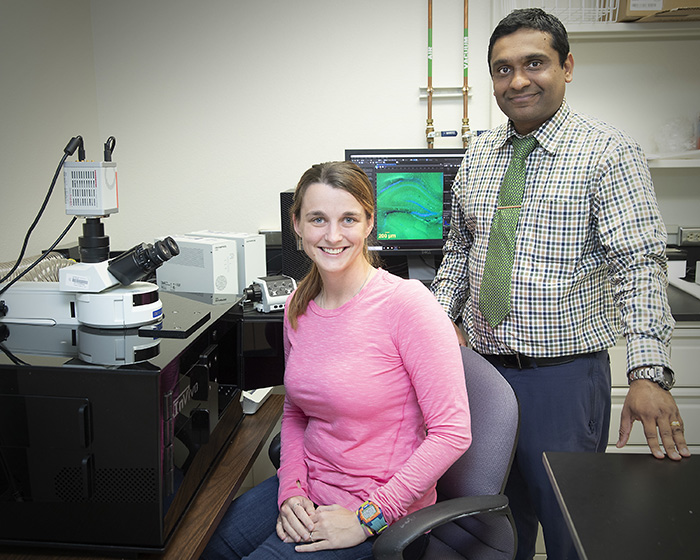CVM Doctoral Student Earns Prestigious NIH Grant
Story by Dorian Martin

Raine Lunde-Young, a doctoral student in the Ramadoss research group at Texas A&M University’s College of Veterinary Medicine & Biomedical Sciences (CVM), has been awarded a prestigious F31 predoctoral grant from the National Institutes of Health (NIH).
NIH F31 grants are unique in that they collectively recognize the quality of Lunde-Young’s research, the excellence of the research lab in which she works, the merits of her faculty mentor, and the exemplary institutional environment. These fellowships are highly competitive.
As Lunde-Young’s mentor, Dr. Jayanth (Jay) Ramadoss, the director of Perinatal Research Laboratory and an associate professor in CVM’s Physiology & Pharmacology Department (VTPP), supported her throughout the proposal writing process, from its inception to submission.
“I’m really grateful for Dr. Ramadoss’ support. An NIH F31 grant is a testament to your aptitude and potential as a researcher as well as your mentor’s and their lab’s capabilities to support your career growth,” Lunde-Young said. “It really helps get your toe in the door. It tells the scientific community that you can write a competitive grant early in your career.”
The NIH F31 fellowship grant is valued at more than $100,000 and subsidizes Lunde-Young’s tuition, fees, and stipendfor three years as she investigates Fetal Alcohol Spectrum Disorders (FASD) in Ramadoss’ research group.
“Raine is a very hardworking student who already has invested more than a decade in the field of fetal alcohol spectrum disorders,” Ramadoss said. “The NIH—and the Research Society in Alcoholism, last year, through one of their most prestigious awards—recognized Raine’s long-term commitment to this field. I believe she will do wonders as she moves on to a postdoctoral fellowship and will continue to be recognized for her contributions to the field.
“The F31 grant adds value to the career development of the graduate student as well as to the lab,” the CVM faculty member said. “Also, it’s about the message it sends. Having these grants in the lab means the lab is able to train scientists for a promising career.”
According to the National Organization on Fetal Alcohol Syndrome, an estimated 40,000 newborns—approximately 1 in 100 babies—are affected by FASD each year. FASD is more prevalent than Down syndrome, cerebral palsy, sudden infant death syndrome (SIDS), cystic fibrosis, and spina bifida combined. FASD can result in physical defects, damage to the brain and central nervous system, and social and behavioral issues.
While it’s common knowledge that alcohol consumption during pregnancy places children at risk, incidence has not decreased. In fact, a recent study indicated that1 in 10 report drinking alcohol during pregnancy.
Lunde-Young is working with Ramadoss to study how fetal brain damage from developmental alcohol exposure is happening.
“Despite more than 30 years of research, we still don’t know how alcohol causes many of these neuro-developmental problems,” Lunde-Young said. “Surprisingly, an area that is understudied is alcohol’s effects on the developing brain vasculature. The brain vasculature is important because during development, blood vessels deliver oxygen and nutrients to support healthy brain growth. Diminished blood vessel function could profoundly affect nutrient and oxygen delivery, which could lead to an array of developmental consequences involving the brain.”
Under this NIH F31 grant, Lunde-Young will use ultrahigh-frequency ultrasonography to noninvasively study regional blood flow distribution in the fetal brain. She also plans to assess blood vessel function by simulating in vivo-like conditions (i.e., temperature, pH, etc.) in an ex vivosetting outside the body, and will evaluate how these blood vessels respond to changes in pressure.
“She’s using state-of-the-art technology to image the fetal brain, to determine how fast blood is flowing in mainly small vessels supplying different brain regions,” Ramadoss said. “She will evaluate whether different parts of the brain are responding differently.”
“These vessels are less than a millimeter in diameter, so until recently, imaging was not really an option,” Lunde-Young said. “Now, with technological advances, we can really get a clear picture of how many hemodynamic parameters are being altered in response to alcohol.”
Lunde-Young’s overall goal for her work that will be supported by the F31 grant is “to lay a foundation for developing potential therapeutic or pharmacological intervention studies that can manipulate, improve, or ameliorate some of the effects of alcohol exposure on development,” she added.
“This research will give us an understanding so that we can move forward and think about treatment options,” she said
###
For more information about the Texas A&M College of Veterinary Medicine & Biomedical Sciences, please visit our website at vetmed.tamu.edu or join us on Facebook, Instagram, and Twitter.
Contact Information: Jennifer Gauntt, Interim Director of CVM Communications, Texas A&M College of Veterinary Medicine & Biomedical Science; jgauntt@cvm.tamu.edu; 979-862-4216


